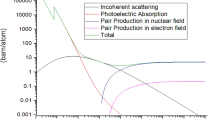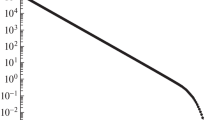Abstract
Monte Carlo Code JA-IPU is used for estimation of Frenkel pairs and their effect on change of resistivity of Iron on irradiation by gamma spectrum of Co60. The Code includes three cascade processes of incident gamma, produced electrons and recoiled atoms and simulation of the lattice structure of the target material. Change in experimentally measured resistivity of Iron is found to vary with number of Frenkel pairs as ~(x − 1) ln N d .



Similar content being viewed by others
References
L E Rehn and R C Birtcher J. Nucl. Mat. 205 31 (1993)
L E Rehn and D E Alexander J. Nucl. Mat. 217 213 (1994)
A Ryazanov Physics of Materials under Neutron and Charged particle irradiation (IAEA Technical Meeting TM-36842) (Austria: IAEA) p 10 (2009)
D E Alexander J. Nucl. Mat. 240, 196 (1997)
V Kumar, N S Raghaw and H S Palsania Nucl. Sci. Eng. 172 151 (2012)
V Kumar, N S Raghaw and H S Palsania International Conference on Mathematics and Computational Methods Applied to Nuclear Science and Engineering (MC 2011) (ed.) E D Larsen (Brazil: Taylor & Francis) p 233 (2011)
A Tundwal, V Kumar and N S Raghaw 15th Int. Sci. Conf. on electric power engineering (EPE) (Czech Republic: IEEE) p 749 (2014) IEEE Xplore doi:10.1109/EPE.2014.6839457
A Tundwal, V Kumar Kerntechnik 80 476 (2015)
J Kwon and A T Motta Ann. Nucl. Energy 27 1627 (2000)
K Fukuyn and I Kimura J. Nucl. Sci. Tech. 40 423 (2003)
M J Norgett, M T Robinson and I M Torrens Nucl. Eng. Des. 33 50 (1975)
G J Dienes and G H Vineyard Radiation Effects in Solids (New York: Interscience publishers) p 92 (1957)
C H M Broeders and A Yu Konobeyev J. Nucl. Mat. 328 197 (2004)
V A Pechenkin, I A Stepanov and Y V Konobeyev Effect of Radiation on Materials: 20th International Symposium (ASTM STP 1405) (eds.) S T Rosinski, M L Grosbeak, T R Allen and A S Kumar (West Conshohocken, PA: American nuclear society for testing materials) (2001)
N Dytlewski and V Inozemtsev Physics of Materials Under Neutron and Charged Particles Irradiations (IAEA report TM-36842) Vienna, November 16–19 (2009)
V Kumar, N S Raghaw, A Tundwal, Y Korovin and I Adam Proceedings of the International Conference NRNU MEPhI-2015 (Obninsk, Russia: NRNU MEPhi) (2015)
T Ozaki and H Kino Phys. Rev. B 69 195113 (2004).
S Glasstone and A Sesonske Nuclear Reactor Engineering (4th ed., vol. 1) p 329 (2002)
J H Hubbell Photon Cross-Sections, Attenuation Coefficients and Energy Absorption Coefficients from 10 keV to 100 GeV (NSRDS-NBS 29) p 56 (1969). http://www.nist.gov/data/nsrds/NSRDS-NBS29.pdf
C H M Broeders, A Y Konobeyev, K Voukelatou IOTA—A Code to Study Ion Transport and Radiation Damage in Composite Materials (Germany: Forschungszentrum Karlsruhe) (2004)
J J Harwood, H H Housner, J G Morse and W G Rauch The Effects of Radiation on Materials (New York: Reinhold Publishing Corporation) p 8 (1958)
N Kadry, A Sawaby, A E Agrami and R Sharkawi Isot. Isot. Environ. Health. Stud. 20 312 (1984)
M J Caturla, T D de la Rubia, M Victoria, R K Corzine, M R James and G A Greene J. Nucl. Mat. 296 90 (2001)
C M C Inclan, I P Hernandez, A L Fabelo and Y A Alfonso Superconductor (eds) A M Luiz (Croatia: Sciyo) p 135 (2010)
A V Kozlov, E N Shcherbakov, S A Averin and F A Garner The Effect of Void Swelling on Electrical Resistance and Elastic Moduli in Austenitic Steels (Semiannual Progress Report) (DOE/ER-0313/32) vol 32 p 147 (2002)
J A Brinkman Am. J. Phys. 24 246 (1956)
Acknowledgments
One of the authors A Tundwal is thankful to GGSIP University for providing Indraprastha research fellowship and IUAC for providing the irradiation facility.
Author information
Authors and Affiliations
Corresponding author
Appendix
Appendix
Based on the linear relationship between N d and T dam given in Fig. 2 a phenomenological approach based on the contribution of Frenkel pairs towards resistivity is developed as follows,
Constant, k depends on the spectrum of incident particle. On integration we can obtain total number of Frenkel pairs, N d
\(\frac{{N_{d} }}{n} = k\left( {\frac{{T_{dam} }}{n} - \frac{{E_{d} }}{n}} \right)\) can be used for calculations per incident particle.The density of displaced atoms may be written as,
Assuming nd is roughly constant, disordered volume may be written as,
From the Eq. (6),
Therefore, using Eq. (2) one can write
In an explanation of resistivity, Brinkman [26] has related it to the disordered volume. Following this, we can write that,
where \(\rho_{0}\) and \(\rho_{D}\) correspond to the resistivity of pristine and highly disordered state of a sample respectively.
In the situation of non-availability of data of resistivity, \(\rho_{D}\) we have assigned \(\rho_{D} = x\rho_{0}\). Here, parameter x ≥ 0 corresponds to a disordered state of irradiated material and it is also spectrum dependent. For example dV = 0 corresponds to \(\rho = \rho_{0}\) and dV = V corresponds to \(\rho_{D} = \rho\). In that sense higher values of x may lead to more interesting results. Thus, relation (9) can be written as,
Putting expression for \(\frac{dV}{V}\) from the Eq. (8), change in resistivity can be approximated by the following relation,
where both ‘k’ and ‘x’ are spectrum dependent. Thus, there is a composite independent variable, \(\frac{{dT_{dam} }}{{N_{d} }}\) on which the resistivity depends linearly.
In case of one irradiation spectrum like Co60 gamma spectrum, \(k = \frac{{d N_{d} }}{{ d T_{dam} }}\), Therefore, the Eq. (11) can be written as,
or there is a linear relation between \(\rho\) and \(\ln N_{d}\),
where \(Z = \left( {{\text{x}} - 1} \right)\rho_{0}\). Taking data from Table 2 in the following Fig. 4 normalized resistivity, \(\rho /\rho_{0}\) has been plotted as a function of (x − 1) ln N d and it can be seen that the normalized resistivity increases linearly with (x − 1) ln N d .
Rights and permissions
About this article
Cite this article
Tundwal, A., Kumar, V. & Datta, A. Gamma radiation induced resistivity changes in Iron. Indian J Phys 91, 293–298 (2017). https://doi.org/10.1007/s12648-016-0915-9
Received:
Accepted:
Published:
Issue Date:
DOI: https://doi.org/10.1007/s12648-016-0915-9





